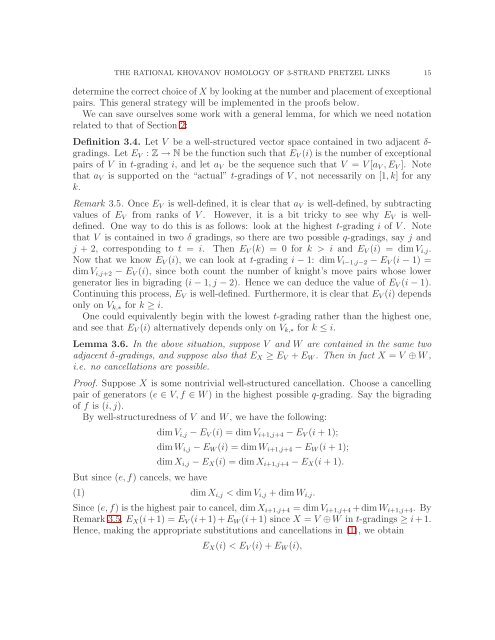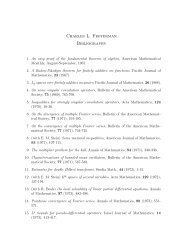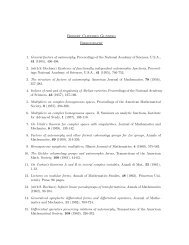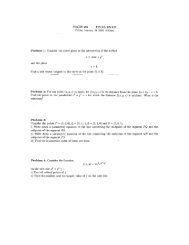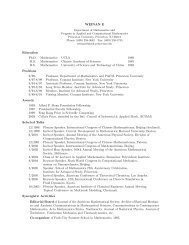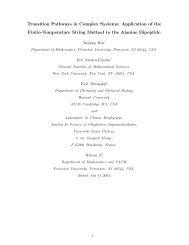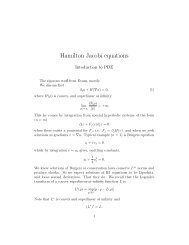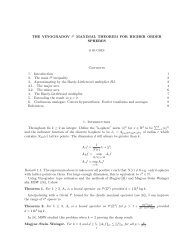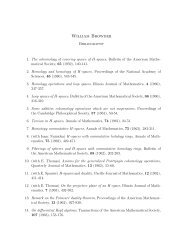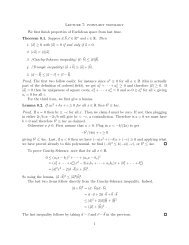The rational Khovanov homology of 3-strand pretzel links
The rational Khovanov homology of 3-strand pretzel links
The rational Khovanov homology of 3-strand pretzel links
Create successful ePaper yourself
Turn your PDF publications into a flip-book with our unique Google optimized e-Paper software.
THE RATIONAL KHOVANOV HOMOLOGY OF 3-STRAND PRETZEL LINKS 15<br />
determine the correct choice <strong>of</strong> X by looking at the number and placement <strong>of</strong> exceptional<br />
pairs. This general strategy will be implemented in the pro<strong>of</strong>s below.<br />
We can save ourselves some work with a general lemma, for which we need notation<br />
related to that <strong>of</strong> Section 2:<br />
Definition 3.4. Let V be a well-structured vector space contained in two adjacent δ-<br />
gradings. Let E V : Z → N be the function such that E V (i) is the number <strong>of</strong> exceptional<br />
pairs <strong>of</strong> V in t-grading i, and let a V be the sequence such that V = V [a V ,E V ]. Note<br />
that a V is supported on the “actual” t-gradings <strong>of</strong> V , not necessarily on [1,k] for any<br />
k.<br />
Remark 3.5. Once E V is well-defined, it is clear that a V is well-defined, by subtracting<br />
values <strong>of</strong> E V from ranks <strong>of</strong> V . However, it is a bit tricky to see why E V is welldefined.<br />
One way to do this is as follows: look at the highest t-grading i <strong>of</strong> V . Note<br />
that V is contained in two δ gradings, so there are two possible q-gradings, say j and<br />
j + 2, corresponding to t = i. <strong>The</strong>n E V (k) = 0 for k > i and E V (i) = dimV i,j .<br />
Now that we know E V (i), we can look at t-grading i − 1: dimV i−1,j−2 − E V (i − 1) =<br />
dimV i,j+2 − E V (i), since both count the number <strong>of</strong> knight’s move pairs whose lower<br />
generator lies in bigrading (i − 1,j − 2). Hence we can deduce the value <strong>of</strong> E V (i − 1).<br />
Continuing this process, E V is well-defined. Furthermore, it is clear that E V (i) depends<br />
only on V k,∗ for k ≥ i.<br />
One could equivalently begin with the lowest t-grading rather than the highest one,<br />
and see that E V (i) alternatively depends only on V k,∗ for k ≤ i.<br />
Lemma 3.6. In the above situation, suppose V and W are contained in the same two<br />
adjacent δ-gradings, and suppose also that E X ≥ E V + E W . <strong>The</strong>n in fact X = V ⊕ W,<br />
i.e. no cancellations are possible.<br />
Pro<strong>of</strong>. Suppose X is some nontrivial well-structured cancellation. Choose a cancelling<br />
pair <strong>of</strong> generators (e ∈ V,f ∈ W) in the highest possible q-grading. Say the bigrading<br />
<strong>of</strong> f is (i,j).<br />
By well-structuredness <strong>of</strong> V and W, we have the following:<br />
But since (e,f) cancels, we have<br />
dimV i,j − E V (i) = dimV i+1,j+4 − E V (i + 1);<br />
dimW i,j − E W (i) = dimW i+1,j+4 − E W (i + 1);<br />
dimX i,j − E X (i) = dimX i+1,j+4 − E X (i + 1).<br />
(1) dimX i,j < dimV i,j + dimW i,j .<br />
Since (e,f) is the highest pair to cancel, dimX i+1,j+4 = dimV i+1,j+4 +dimW i+1,j+4 . By<br />
Remark 3.5, E X (i+1) = E V (i+1)+E W (i+1) since X = V ⊕W in t-gradings ≥ i+1.<br />
Hence, making the appropriate substitutions and cancellations in (1), we obtain<br />
E X (i) < E V (i) + E W (i),


